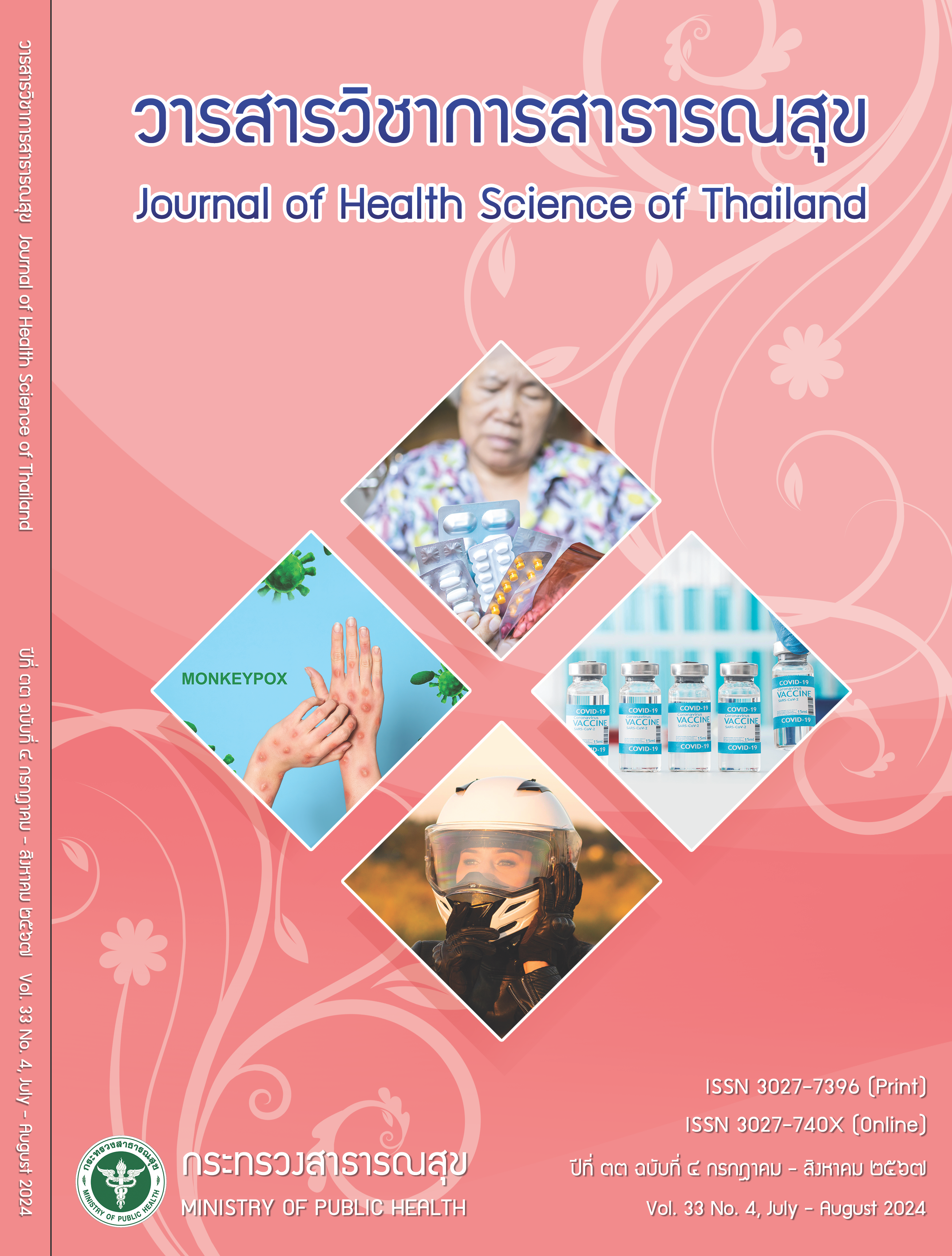Effectiveness of the Public Health Emergency Operation Center (Pheoc) in the Context of Coronavirus Disease 2019 at the Provincial Level
Keywords:
effectiveness, public health emergency, operation center, PHEOC, coronavirus disease 2019, COVID-19Abstract
This research aimed to evaluate the effectiveness of the PHEOC for COVID-19 at the provincial level, analyse the associate, and explain the variations between personnel characteristics, organizational characteristics, management policies and practices, and environmental characteristics at the provincial level. Data were collected by using questionnaires developed based on the concepts of Steers and Mott. The samples were 53 provincial public health offices selected by stratified random sampling. They were the chief or deputy chief of the provincial public health office, the head of the communicable disease control group, and the head of the strategic development group, with a total of 159 informants. The data were analyzed using descriptive statistics, Pearson product-moment correlation, and multiple regression analysis. It was found that the overall effectiveness of the PHEOC for COVID-19 was highly significant (Mean=3.89, SD=0.50). It was observed that all four factors had a moderately positive correlation with the effectiveness of the PHEOC for COVID-19, with personnel characteristics (r=0.64), organizational characteristics (r=0.64), policy and operation (r=0.68), and environmental characteristics (r=0.70) all showing statistically significant relationships (p<0.01). Moreover, personnel characteristics, environmental characteristics, and policy and operation collectively account for 57.8% of the variance in the effectiveness of the PHEOC for COVID-19 at the provincial level. The inability to explain the variability of the performance of PHEOC might stem from the fact that commanders at each center define the organizational structure, roles, authority, and operational procedures according to the templates provided by the Ministry of Public Health. This resulted in minimal variation in the organizational characteristics of PHEOC across provinces. Consequently, organizational characteristics emerged as the least influential factor on performance. This research could be utilized to enhance provincial PHEOC, which might involve formulating policies to strengthen organizational commitment, ensuring that all systems and processes within the organization are aligned, and implementing SMART PHEOC policies focused on digital system development, digital skill enhancement for personnel, cybersecurity, and quality management.
Downloads
References
World Health Organization. Coronavirus disease (COVID-19) pandemic [Internet]. 2020 [cited 2021 Jan 25]. Available from: https://www.who.int/europe/ emergencies/situations/covid-19
World Health Organization. Timeline: WHO’s COVID-19 response 2021 [Internet]. 2021 [cited 2021 Jan 25]. Available from: https://www.who.int/emergencies/ diseases/novel-coronavirus-2019/interactive-time¬line#!
กระทรวงสาธารณสุข. ประกาศกระทรวงสาธารณสุข (ฉบัับ ที่ 3) พ.ศ. 2563 เรื่อง ชื่อและอาการสำคัญของโรคติดต่ออันตราย.ราชกิจจานุุเบกษา ฉบับประกาศทั่วไป เล่ม137, ตอนพิเศษ 48 ง (ลงวันที่ 26 กุมภาพันธ์ 2563).
องค์การอนามัยโลกประจำประเทศไทย, กระทรวงสาธารณสุข. การทบทวนร่วมระหว่างการปฏิบัติการงานด้านสาธารณสุุขเพื่อตอบสนองต่อสถานการณ์โรคโควิด 19 ในประเทศไทย. นนทบุรี: องค์การอนามัยโลกประจำประเทศไทย; 2563.
กระทรวงสาธารณสุข. คำสังกระทรวงสาธารณสุข ที่ 101/ 2563 เรื่อง จัดตังศูนย์ปฏิบัติการฉุกเฉินด้านการแพทย์และสาธารณสุข กรณีโรคติดเชื้อไวรัสโคโรนา 2019 (pneumo¬nia caused by novel coronavirus 2019) (ลงวันที่ 30 มกราคม 2563). นนทบุรี: กระทรวงสาธารณสุุข; 2563.
Steers RM. Organizational effectiveness: a behavioral view. California: Goodyear Publishing Company; 1977.
Mott PE. The characteristics of effective organizations. New York: Harper & Row; 1972.
Deming WE. Elementary principles of the statistical control of quality: a series of lectures: Tokyo: Nippon Kagaku Gijutsu Remmei; 1950.
ทิพวรรณ สำเภาแก้ว. ปัจจัยการบริหารที่ส่งผลต่อประสิทธิผลของสถานศึกษา สังกัดสำนักงานเขตพื้นที่การศึกษาประถมศึกษาสระบุรี เขต 2 [วิทยานิพนธ์ปริญญาครุศาสตรมหาบัณฑิต]. ฉะเชิงเทรา: มหาวิทยาลัยราชภัฏราชนครินทร์; 2560.
วริศรา อรุณกิตติพร. ปัจจัยการบริหารของผู้บริหารสถานศึกษาที่ส่งผลต่อประสิทธิผลของสถานศึกษาสังกัดสำนักงานเขตพื้นที่การศึกษาประถมศึกษาตราด. ชลบุรี: มหาวิทยาลัยบูรพา; 2561.
Downloads
Published
How to Cite
Issue
Section
License
Copyright (c) 2024 Ministry of Public Health

This work is licensed under a Creative Commons Attribution-NonCommercial-NoDerivatives 4.0 International License.







